Butterfly Nebula - NGC 6302 – Constellation Guide (original) (raw)
The Butterfly Nebula is a bipolar planetary nebula located approximately 3,400 light-years away in the constellation Scorpius. Named for its resemblance to a butterfly, the nebula has a wingspan that stretches three light-years across. It is sometimes also called the Bug Nebula. The nebula has the designation NGC 6302 in the New General Catalogue and Caldwell 69 (C69) in the Caldwell catalogue of deep sky objects visible in amateur telescopes.
Planetary nebulae are formed when Sun-like stars reach the final stages of their lives. Once they run out of fuel, these stars start shedding their outer layers and releasing gas at high speeds. The expelled material forms the planetary nebula. As the central stars begin to heat up, the radiation from the stars causes the clouds of ejected material to glow.
The term planetary nebula was first used by William Herschel in the 1780s. The objects got this name because when observed through a small telescope their appearance resembles that of a planet. Even though the term is inaccurate and does not really describe these objects, it is still used today.
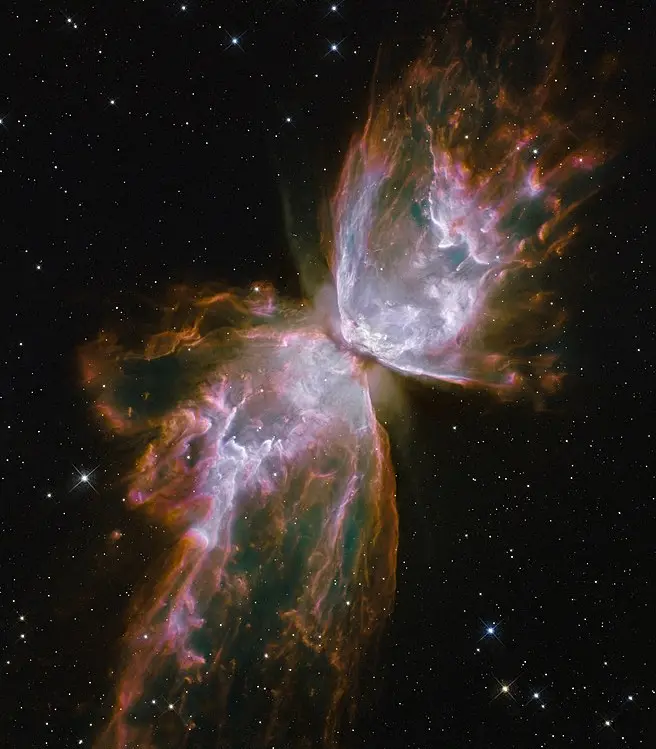
The image of the Butterfly Nebula taken with the Wide Field Camera 3 (WFC3) aboard the Hubble Space Telescope (HST) reveals a history of ejections from the star. The star first evolved into a huge red-giant star, with a diameter of about 1,000 times that of our Sun. It then lost its extended outer layers. Some of this gas was cast off from its equator at a relatively slow speed, perhaps as low as 20,000 miles an hour, creating the doughnut-shaped ring. Other gas was ejected perpendicular to the ring at higher speeds, producing the elongated “wings” of the butterfly-shaped structure. Later, as the central star heated up, a much faster stellar wind, a stream of charged particles traveling at more than 2 million miles an hour, plowed through the existing wing-shaped structure, further modifying its shape. The image also shows numerous finger-like projections pointing back to the star, which may mark denser blobs in the outflow that have resisted the pressure from the stellar wind. The nebula’s reddish outer edges are largely due to light emitted by nitrogen, which marks the coolest gas visible in the picture. WFC3 is equipped with a wide variety of filters that isolate light emitted by various chemical elements, allowing astronomers to infer properties of the nebular gas, such as its temperature, density, and composition. The white-colored regions are areas where light is emitted by sulfur. These are regions where fast-moving gas overtakes and collides with slow-moving gas that left the star at an earlier time, producing shock waves in the gas (the bright white edges on the sides facing the central star). The white blob with the crisp edge at upper right is an example of one of those shock waves.
NGC 6302 was imaged on July 27, 2009, with Hubble’s Wide Field Camera 3 in ultraviolet and visible light. Filters that isolate emissions from oxygen, helium, hydrogen, nitrogen, and sulfur from the planetary nebula were used to create this composite image. These Hubble observations of the planetary nebula NGC 6302 are part of the Hubble Servicing Mission 4 Early Release Observations. Image credit: NASA, ESA and the Hubble SM4 ERO Team
The Butterfly Nebula has an apparent size of at least 3 arcminutes. It has a bipolar structure with two primary lobes and possibly another pair of lobes from an earlier phase of mass loss. The nebula’s central star is obscured by a dark lane that runs through the nebula’s waist.
The equatorial dark lane is believed to be a dusty disk surrounding the invisible central star. In 2005, observations of the disk with the Hubble Space Telescope, Very Large Telescope, and James Clerk Maxwell Telescope revealed an elongated central core tracing the disk. Astronomers derived a mass of 0.03 solar masses for the dust in the disk. The study was published in Monthly Notices of the Royal Astronomical Society.
NGC 6302 has one of the most complex structures ever seen in a planetary nebula, one that includes knots, ionization walls and sharp edges to the lobes. The nebula has a prominent northwestern lobe that is believed to have formed about 1,900 years ago, when an eruptive event resulted in material being expelled from the central star.
The lobe extends up to 3 arcminutes from the planetary nebula nucleus (PNN). It contains a circular part whose individual parts are expanding at speeds proportional to their distance from the PNN. The measured flow velocity of the lobe is 263 km/s, while the very edge of the lobe shows an outward velocity of more than 600 km/s.
The western boundary of the lobe shows features that indicate that the material is colliding with existing globules of gas in this region.
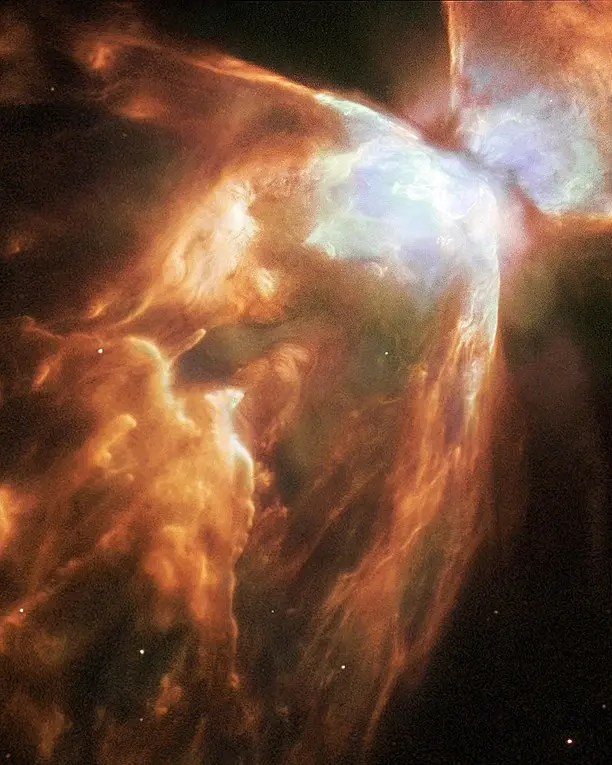
The Bug Nebula, NGC 6302, is one of the brightest planetary nebulae known. The fiery star at its center is shrouded by a blanket of icy hailstones. This NASA Hubble Wide Field Planetary Camera 2 image shows impressive walls of compressed gas, laced with trailing strands and bubbling outflows. Image credit: NASA, ESA and A.Zijlstra (UMIST, Manchester, UK) (CC BY 2.0)
The dust in the Butterfly Nebula contains both oxygen-bearing silicate molecules and polycyclic aromatic hydrocarbons (PAHs). The presence of carbon-bearing PAHs in an oxygen-rich environment is only seen in bipolar nebulae. The dual chemistry is unusual in post-AGB objects (evolved red giant stars that shed their outer layers) because stars are either oxygen-rich or carbon-rich, and they change from one composition to the other as they evolve.
In 2023, a team led by Bruce Balick, a professor emeritus of astronomy at the University of Washington, reported observing dramatic changes in the material within the Butterfly’s wings over a period of 11 years. The changes are driven by powerful winds. Such activity is puzzling for astronomers because the central star should not have any fuel left, and the fast-changing interior structure is difficult to explain using the existing models of planetary nebula evolution. The study was presented at the 241st meeting of the American Astronomical Society in Seattle, Washington, on January 12, 2023.
The team compared images of NGC 6302 taken by the Hubble Space Telescope in 2009 and 2020 to chart the speeds and growth patterns of features in the nebula’s wings. Most of the analysis was carried out by Lars Borchert, a graduate student at Aarhus University in Denmark.
Studying the Hubble images, the team found about half a dozen jets that are pushing material outwards in asymmetrical outflows beginning 2,300 years ago and ending 900 years ago. The paths of the jets intersect, forming unusual structures in the wings.
While hypotheses to explain the jets have not been confirmed, astronomers surmise that the central star may have merged with a companion star or pulled material from a nearby star to create complex magnetic fields and produce the jets.
Astronomers believe that imaging the nebula’s centre with the James Webb Space Telescope (JWST) may provide important insights into the hidden central star and the shaping processes of the nebula. Webb will be able to peek through the intervening dust and reveal the star at the center of the nebula in infrared light.
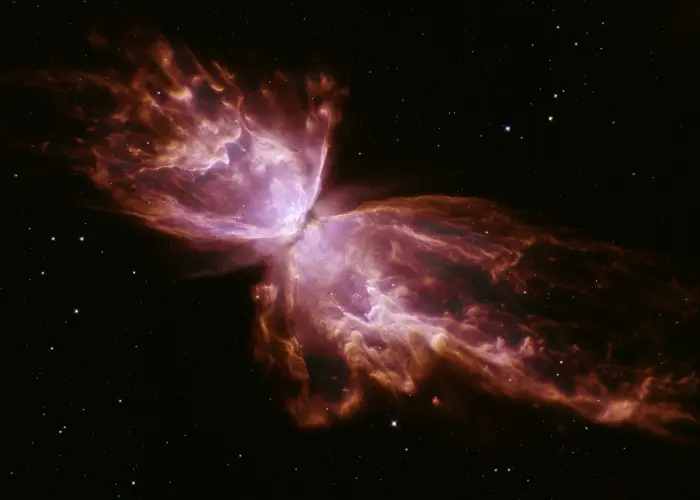
Butterfly Nebula (C69), image credit: Judy Schmidt (CC BY 2.0)
Central star
The star at the centre of the Butterfly Nebula is a white dwarf with an estimated mass of about 0.64 solar masses. Catalogued as HD 155520, the stellar remnant is surrounded by a dense disk of dust and gas at the equator. The disk is believed to have caused the outflow of material from the star to form the bipolar butterfly shape, resembling an hourglass.
The central star of NGC 6302 is one of the hottest stars known. It has a surface temperature of more than 250,000 degrees Celsius (450,000° F). The exceptionally high temperature indicates that the progenitor star was very large.
The dust cloud around the star has an estimated temperature of 18,000° C. The gas in the nebula is moving very quickly at over 600,000 miles (965,606 kilometres) per hour.
The central star was identified in 2009, when observations with the Wide Field Camera 3 aboard the Hubble Space Telescope (HST) directly detected it. It lies at the nebula’s centre on the foreground side of the equatorial disk. Astronomers found that the star was close to the white dwarf cooling track and that it was fading at a rate of almost 1% per year. They suggested that, in order to photoionize the nebula, the star had to have a temperature of over 200,000 K.
However, in 2021, a team led by Joel H. Kastner of the Rochester Institute of Technology compared the Hubble images taken with the Wide Field Camera 3 and found that the central star may be hidden within shell-like inner lobe features.
The team suggested that the object previously identified as the PNN was a foreground field star. Additionally, they identified a bright, S-shaped 1.64 µm [Fe II] emission in the southern interior of the east lobe rim and the northern interior of the west lobe rim. This may be a zone of shocks caused by the strong, fast winds from the central star. The direction of the wind is surprisingly misaligned with the nebula’s main axis of symmetry.
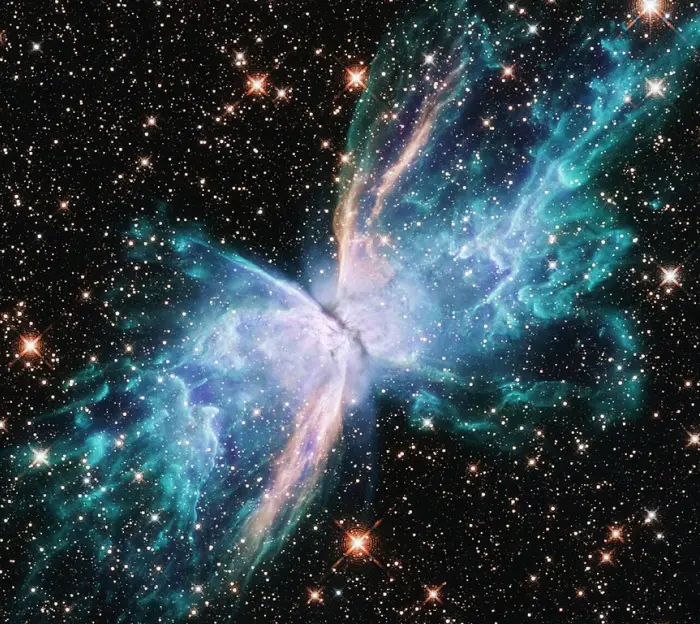
This image from the NASA/ESA Hubble Space Telescope depicts NGC 6302, commonly known as the Butterfly Nebula. NGC 6302 lies within our Milky Way galaxy, in the constellation of Scorpius. The glowing gas was once the star’s outer layers, but has been expelled over about 2,200 years. The butterfly shape stretches for more than two light-years, which is about half the distance from the Sun to the nearest star, Proxima Centauri. New observations of the object have found unprecedented levels of complexity and rapid changes in the jets and gas bubbles blasting off of the star at the centre of the nebula. Image credit: NASA, ESA, and J. Kastner (RIT) (CC BY 2.0)
The planetary nebula nucleus (PNN) was only detected in recent decades because it is obscured by the dusty torus that absorbs a large amount of the light coming from the nebula’s central region. However, the star shines brightly in ultraviolet wavelengths.
The central star was originally much more massive, with a mass about five times solar. It ejected most of its mass in the event that resulted in the formation of the nebula. The star is currently evolving into a white dwarf. The ultraviolet radiation from the star is making the nebula glow.
Facts
The Butterfly Nebula has been known since at least 1888, when it was included in the New General Catalogue by Danish astronomer John Louis Emil Dreyer. Scottish astronomer James Dunlop may have discovered it in 1826.
The first known study of NGC 6302 dates from 1907, when American astronomer Edward Emerson Barnard drew and described the nebula. Barnard credited Dunlop for the discovery but may have been mistaken.
The dark lane that obscures the centre of the nebula was found to have an unusual composition. In 2002, researchers found evidence for crystalline water ice, crystalline silicates and quartz. If correct, this would have been the first discovery of carbonates outside the solar system. However, the discovery is disputed because the likelihood of carbonates forming in non-aqueous environments is low.
The Butterfly Nebula was one of the bipolar planetary nebulae in the Milky Way’s central bulge that were discovered to be preferentially aligned to the galactic plane of the Milky Way. The discovery, announced on September 4, 2013, suggests that there is an external force that is shaping the orientation of these nebulae, possibly a strong magnetic field emitted by the galaxy’s bulge.
The study was conducted by Bryan Rees and A. A. Zijlstra of the University of Manchester, UK, who studied over a hundred planetary nebulae in the Milky Way’s bulge using the Hubble Space Telescope and European Southern Observatory’s New Technology Telescope (NNT). The astronomers found that the bipolar nebulae were in a surprising alignment with each other, with their long axes aligned along the plane of the Milky Way galaxy. The studied nebulae are in different locations, they have different compositions and histories, and they do not interact with each other, yet they are mysteriously aligned with one another. This is not the case with all planetary nebulae, only the bipolar ones.
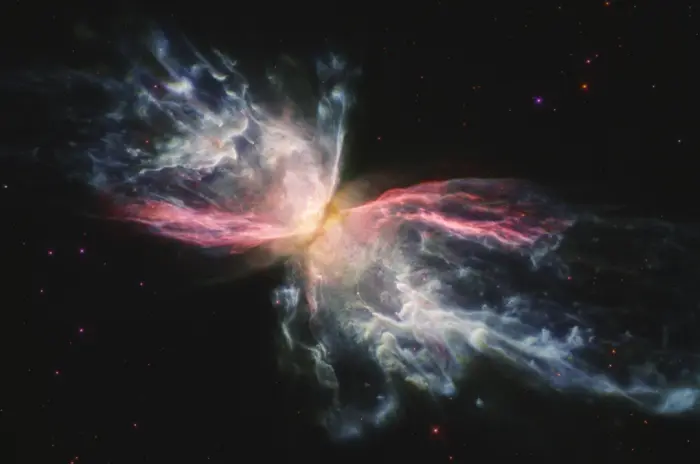
NGC 6302 – Observations from 2019 (Prop 15953/Joel Kastner) reveal [Fe II] emission, shown here in pink, along the edges of the bipolar outflows of this young planetary nebula. Image credit: Judy Schmidt (CC BY 2.0)
The shape of planetary nebulae is believed to be determined by the rotation of the central star or star system. The wing-like shape of bipolar nebulae is thought to be a result of jets blowing mass outwards from the central star perpendicular to its orbit. While the shape of planetary nebulae is determined by the characteristics of the progenitor stars, the new finding suggests that the central bulge of the Milky Way with its magnetic fields has a stronger influence over the entire galaxy than previously thought.
The Butterfly Nebula (NGC 6302) shares its name with several other well-known planetary and emission nebulae. These include the planetary nebula M2-9, also known as Minkowski’s Butterfly or the Twin Jet Nebula, in the constellation Ophiuchus, the planetary nebulae NGC 2346 in Monoceros and NGC 6881 in Cygnus, and the emission nebula IC 1318, better known as the Sadr Region or the Gamma Cygni Nebula, located at the centre of the Northern Cross in Cygnus.
Location
The Butterfly Nebula is located in the constellation Scorpius. It can be found using the stars of the Fish Hook, an asterism that forms the body, tail and stinger of the celestial Scorpion. The nebula lies along the imaginary line extended from Iota1 Scorpii to Larawag, just north of the midpoint of the line connecting Shaula at the Scorpion’s stinger and the visual double star Mu Scorpii, whose two components are formally named Pipirima and Xamidimura.
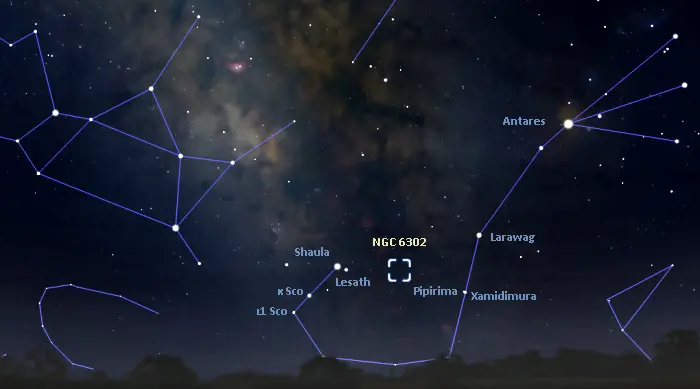
The location of the Butterfly Nebula (NGC 6302), image: Stellarium
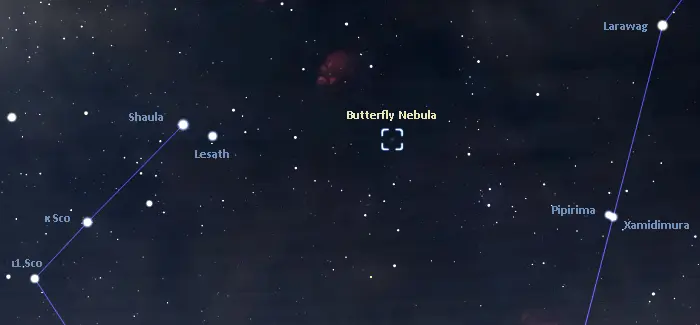
NGC 6302 location, image: Stellarium
The Butterfly Nebula appears in the same area of the sky as the Cat’s Paw Nebula (NGC 6334), a large emission nebula located 4,370 light-years away.
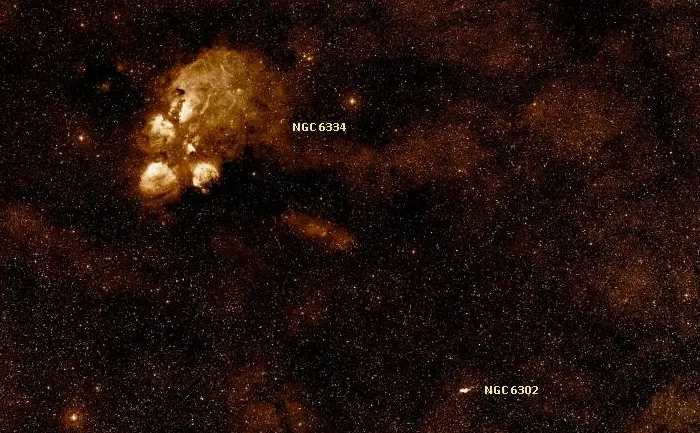
The Cat’s Paw Nebula (NGC 6334) and the Butterfly Nebula (NGC 6302), image: Wikisky
At declination -37°, the Butterfly Nebula is visible from locations south of the latitude 53° N, but it never rises very high above the horizon for observers in the mid-northern latitudes.
The best time of the year to see NGC 6302 and other deep sky objects in Scorpius is during the month of July, when the constellation climbs higher above the horizon in the evening.
Butterfly Nebula – NGC 6302
| Constellation | Scorpius |
|---|---|
| Right ascension | 17h 13m 44.211s |
| Declination | −37° 06′ 15.94″ |
| Apparent magnitude | 7.1B |
| Absolute magnitude | -3.0B (-3.3 to -2.6) |
| Apparent size | >3′.0 |
| Distance | 3400 ± 500 light-years (1040 ± 160 parsecs) |
| Radius | >1.5 ± 0.2 light-years |
| Names and designations | Butterfly Nebula, Bug Nebula, NGC 6302, Caldwell 69, Sharpless 6, Gum 60, RCW 124, PK 349+01 1, ESO 392-5, Hen 2-204, ARO 502, Sh 1-3, Sh 2-6, PN Sa 2-180, PN G349.5+01.0, VV’ 168, VV 94, WRAY 16-259, HD 155520 |